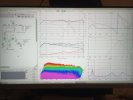+/-3dB is not really a bad alignment in such things. Sometimes more parts really aren't warranted if it still doesn't fix the issues for a preferably better result.
The lower dip is no different than the actual known BBC dip from the original LS3/5A, as it placed focus on the vocals and cleaned up the unnecessary warmth for radio. Many people love this about that old style, and even Jeff Bagby's Continuums were voiced purposely this way. Sometimes warmth can throw mud on the midrange.
The upper dip area is what is typically referred to as the most sensitive region to our ears, and what most people describe and practice as BBC dip, or a trough from 1-5k. It also makes forward/worse recordings easier to tolerate.
The 100-200Hz area is known to help fake a bit of bass in smaller designs for emphasis and make them sound larger and fuller than they are. In PR designs with the more than typical EBS rolloff slope on the low end, this can also help the sound with punch, as Erin described it.
Would I call these an 'accurate' speaker? I don't know that it's not accurate for someone with lesser recordings as their majority of their collection. It seems to me that these could totally satisfy a group of hard rock/hiphop followers, but maybe leave the orchestral or jazz lover a bit unimpressed.
My listening sessions were brief the twice I've heard them, but the bass was solid and deep, and the sound was not awful as we know some commercial outfits have been at these shows. I would like more time with them. However, I feel the tradeoffs made in this design lend well to better intelligibility for less fatigue, and likely target a certain area of listeners.

